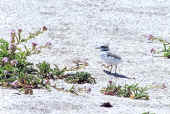Snowy Plovers
 The western snowy plover is six inches long, has light black, brown and white feathers with dark patches on either side of the neck, behind the eyes, and on the forehead. They can be hard to spot. Watch for them as they scurry down to the water's edge for food. When resting, they choose depressions in the sand, such as footprints, where they are camouflaged and out of the wind.
The western snowy plover is six inches long, has light black, brown and white feathers with dark patches on either side of the neck, behind the eyes, and on the forehead. They can be hard to spot. Watch for them as they scurry down to the water's edge for food. When resting, they choose depressions in the sand, such as footprints, where they are camouflaged and out of the wind.
Plovers feed and nest on the beach just above high tide lines, where human activity is the greatest. The coastal population breeds along the Pacific coast from southern Washington to southern Baja California, Mexico, with the majority of birds breeding along the California coast. Nesting season runs from mid-March through mid-September. Plovers usually lay three eggs. Both eggs and nests are well camouflaged and extremely hard to see even at close range. Mothers incubate the nests during the day and fathers at night. Chicks leave the nest within hours of hatching but cannot fly for a month.
At Francis State Beach, plovers are protected in fenced areas along the bluffs just north of the campground. The fences were erected in 1995 to keep the plover nesting areas free from human and animal activity to allow for successful breeding.
Once numbering in the thousands, it is estimated that less than 2000 western snowy plovers survive along the coast. The western snowy plover is listed under the Federal Endangered Species Act as a threatened species because of loss of nesting habitat due to human development, invasion of non-native plants such as European beach grass and predation by ravens, foxes, dogs and cats.
The Half Moon Bay Ranger Station sponsors a Plover Watch Volunteer program. Volunteers are identified by maroon jackets and baseball caps. They are on the beach during nesting season to spot nests and help build enclosures around them to protect the eggs. Volunteers study and collect data about the snowy plovers and educate the public about the snowy plover. For information on how to become a volunteer or other questions, please contact the Half Moon Bay State Beach Ranger Station.
